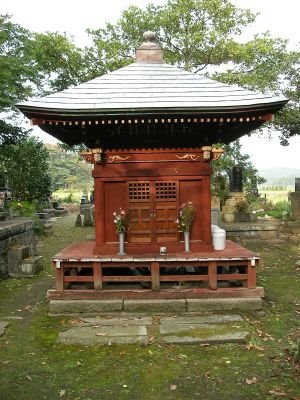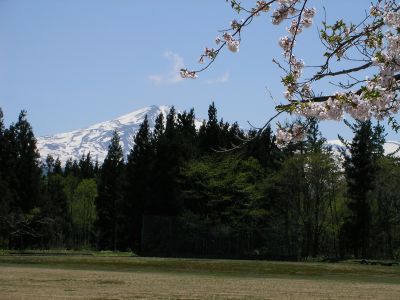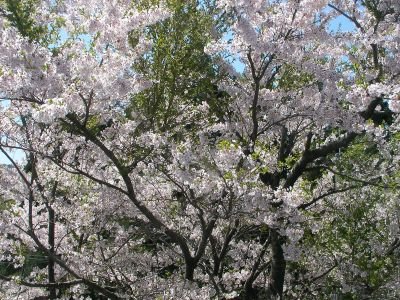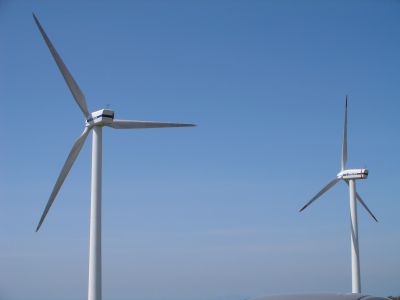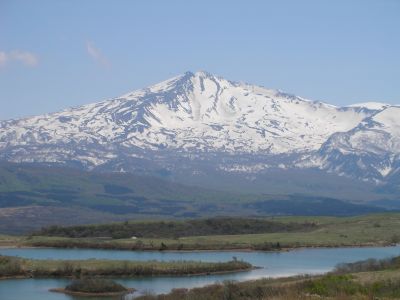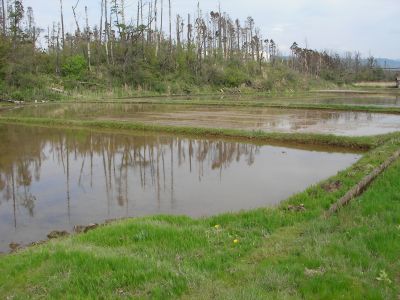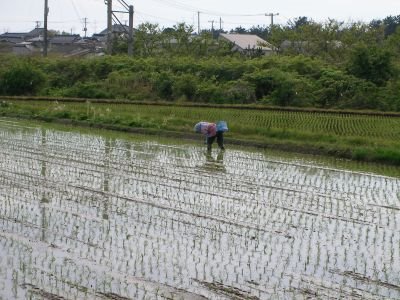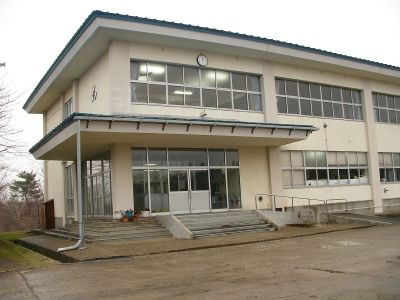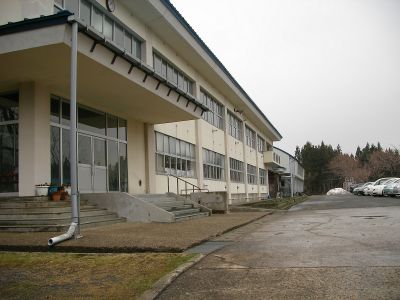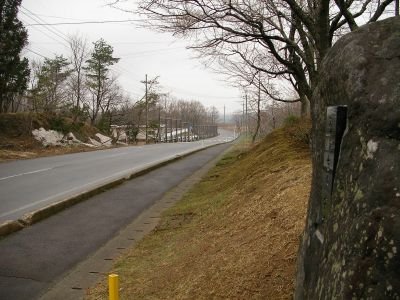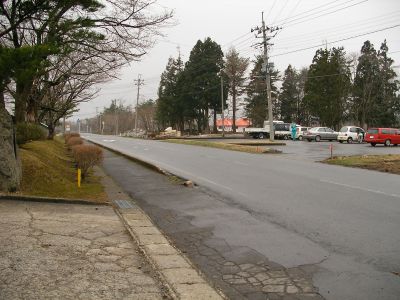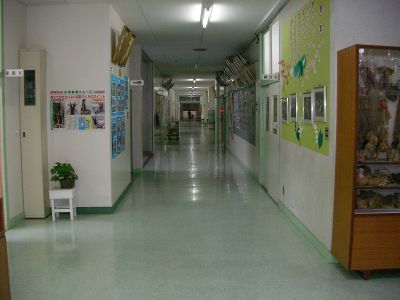(I actually wanted this post and the one below it to be in the same post, but I had too many pictures and it didn't fit. Please keep reading down as if it were one post.)
Yesterday both Atsuko and I were bored, so we decided to do painting. First we had lunch in Kisakata. On the way back, as we were passing the turn off for Kanman Temple, Atsuko said "Do you want to see the temple?" I said I did, so we turned around and went back.
Here is a statue of Basho, a famous poet (artist?) who came to Kanmanji however many hundreds of years ago. Before I show you the rest of the photos, I should tell you a little bit about the history of this area so you know what you are looking at. In the past, both Kisakata and Konoura were actually the sea. About 2500 years ago, a large eruption of Mt. Chokai blew a large hole in the side of the mountain. The rock that was blown off the mountain fell down in large island-sized boulders into the nearby ocean, creating the famous '99 islands of the north' (of which there were actually 103. They were named after the 'real' 99 islands, which are somewhere near Nagasaki I believe.) The density of these islands caused the water between them to be more like a lagoon than the open sea.
Before I show you the rest of the photos, I should tell you a little bit about the history of this area so you know what you are looking at. In the past, both Kisakata and Konoura were actually the sea. About 2500 years ago, a large eruption of Mt. Chokai blew a large hole in the side of the mountain. The rock that was blown off the mountain fell down in large island-sized boulders into the nearby ocean, creating the famous '99 islands of the north' (of which there were actually 103. They were named after the 'real' 99 islands, which are somewhere near Nagasaki I believe.) The density of these islands caused the water between them to be more like a lagoon than the open sea.
A long time ago, I heard 1200 years, the original Kanman Temple (Kanmanji) was built on the largest of the islands. The road to the front gate ran along a beach. Waves lapped at the feet of the graveyard. Since the island was made out of one giant rock, the ground was solid and dry enough for such things.
A couple of hundred years ago, a large earthquake raised this whole area up. The lagoon drained, creating the land that Konoura and Kisakata sit on today. But that left the islands stranded on dry land. You can still see them today. They still look very definitely like islands. Islands sitting amidst a sea of rice.
This stone bench at the side of the old road used to be on the shore. People could sit here and look out over the sea, and the 99 islands.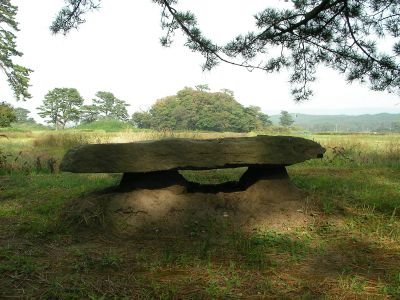 Here are a few islands. You can see that they are certainly islands and not hills.
Here are a few islands. You can see that they are certainly islands and not hills. Here is the old road up to the front gate. Now the road approaches from another angle. I am not to sure why there was an old road. I mean, who needed to use it when everyone approached the island from the other side by boat? I guess it's just traditional for a temple to have one of these.
Here is the old road up to the front gate. Now the road approaches from another angle. I am not to sure why there was an old road. I mean, who needed to use it when everyone approached the island from the other side by boat? I guess it's just traditional for a temple to have one of these. Japanese people are so hospitable they even give clothes to their statues.
Japanese people are so hospitable they even give clothes to their statues. Continued below . . .
Continued below . . .
Out of the 45 first grade students we have at Konoura Jr. High, only 40 can be said to come to school on a regular basis. The other five children, for one reason or another, feel that they cannot face the pressures of Jr. High life. I don't quite understand what happened. All the students attended Elementary fine. One of the girls was in the English club there, and I remember her as an insanely energetic, confident girl who was always laughing. Now she is shy and introverted. What is more scary is that the change occured over the two weeks between the end of Elementary and Jr. High.
Another of the boys was also a confident young fellow at Elementary. He came to the Jr. High every day for the first month of term and then all of a sudden he just disappeared. On the few days he does come to school he looks absolutely terrified, as if he is ready to burst into tears at any moment.
Another student had a physical disability last year which held him back for a while. He is fine now, but he is emotionally in an even worse state than the other lost children. If his mother drops him off at school he refuses to enter the building and then runs back home.
Why is this happening? Is it the stress? I know that Japanese kids are under more pressure than NZ kids are. But apart from the boy who dissappeared after one month of Jr. High, the kids were not even at school enough to find out just how much stress they would personally be under. There is something else going on with them, and it scares me sometimes.
I was watching the news the other day, and there was a segment about these lost children. Apparently this year there are 120,000 Elementary and Jr. High kids in Japan who refuse to go to school. 120,000? Sure Japan has a lot of people, but that is what, 3 or 4% of all school children? More? That's insane! Apparently these children are studying through correspondence courses, but why should they have to?
I personally think that the lack of proper counselling and mental health awareness in Japan may be a major cause of this problem.
* * *
On a lighter note today I ate a half-sponge-half-cheesecake, with chopsticks. Because, you know, I am Japanese.
Every week after my evening English class, my friend Atsuko drives me home. We then sit in her car and gossip for a while. There are several reasons for this. One; Atsuko's car is very comfortable. Two; we can look at the weirdos that come out at night. There are plenty of late night power-walkers, of course. One of my neighbours gets home at 9.30pm and then always leaves again two minutes later. Why? But the strangest sight of all has to be Mr. Yamada. He is the caretaker of the community centre where my English class is held. After he locks up, he must go home for a while and then set out on his evening stroll. Every Wednesday we see him walk past at about 10pm. With a BIRD on his shoulder. Yes, he takes his pet bird for a walk.
Last night for some I reason felt like going for a walk too. I saw Mr. Yamada by the fitness gym, squatting on the ground. He was picking his bird up off the ground and putting it back on his shoulder. Of course, I immediately thought of the Dead Norwegian Parrot. Is Mr. Yamada's parrot alive, and it for some reason hopped of his shoulder and onto the ground? If so, why doesn't it fly away? Or maybe it's a dead parrot, and the whole situation is even more bizarre that it seems at first.
After months of practice, tens of thousands of yen and many hours of muscle aches it was finally time for me to go to Sapporo to perform in the Yosakoi Soran Matsuri. It was a trip filled with fun times and difficult times, but all in all it was an experience I would repeat again in an instant.
I am a member of two yosakoi soran teams; the Kisakata team Kafumai and Saihoku Repputai, a team from Wakkanai City at the most northern point in Hokkaido. It was Saihoku Repputai that went to Sapporo. Although the core of the team and most of the members live in Wakkanai, there are also members in Sapporo, Honjo, Nikaho (who are members of Kafumai too) and there are a few members in Yuza machi (Yamagata ken). We study the year’s dance by video in three separate groups, Wakkanai, Sapporo and Tohoku, and only join together as one team for the big festivals.
On the morning of Friday, 9th of June, the Tohoku members who were going to Sapporo met at Akita airport. There were two people from Yuza, ten from Nikaho City (mostly from Kisakata) and two people from Honjo. We flew to New Chitose Airport, took the train into Sapporo and then took another train clear out the other side of Sapporo to meet the rest of the team and to practice in a small town hall somewhere. Afterwards we all went back to Sapporo together and checked into our hotel. I ate Sapporo ramen that evening. I think I am going to have to wait until I forget the delicious taste of Sapporo ramen before I can enjoy any ramen here.
On Saturday we began our two days of performances. We all met in the hotel lobby in our costumes and makeup, received our subway passes and then set out to Oodori in the city centre. Of course it was raining in the morning when we had our most difficult performance; the Oodori parade, which is where teams perform their dance five times in a row without a rest. That was twenty minutes of strenuous exercise in the rain while wearing a costume. The person with the hardest job was the flag waving guy. That flag had to have been nearly three metres long, and when soaked in rain it must have weighed a ton. The male members of the team had to quickly wring the flag out between the third and fourth dances while moving into position for the fourth dance.
After we had finished at Oodori, we got on the subway and headed out to a suburb of Sapporo to dance twice down a narrow road. We had twenty minutes to stuff bentos down our throats and then we were on the subway again going to another area of Sapporo to dance three times in a row down a wide road. By this time the rain had stopped and the wind had picked up so our costumes dried. I received a medal from a festival staff member, apparently because I am a gaijin. The medal said ‘suki desu’(I like you) on it. Actually, a few other people in the team received medals. They were all young people too.
We headed to a stadium somewhere for our last dance of the day. Although the venue was a stadium, the performance was on the road curving around the outside of the stadium, and therefore was another parade. We were all very tired by this stage because parade dances are very hard and we had already done ten of them, but we did our best. The wind picked up some more as we went to dance which caused the skirts of our costumes to blow up around our ears. We were wearing white shorts just in case we had that problem, but they were kind of transparent so effectively all us women were showing our knickers to the audience for the duration of the dance. To tell you the truth, I was too exhausted to care at that point.
We only danced once at the stadium, brining the total of the day to eleven dances, all of them parade versions. And the day wasn’t over yet. After a quick dinner, we all went back to the city centre, many people in strange and amusing costumes, to dance simple dances with all the other teams. There were thousands of us just having a good time. It was wonderful.
Sunday dawned bright and sunny. Also, the day’s schedule was much easier than Saturday’s had been. First, we went to Sapporo JR Station to perform a stage dance. When performing on stage we only had to dance once, and we didn’t have to go anywhere so it was quite easy. Next we went to the big stage in the city centre. That was the dance that (I assume) had TV coverage within Hokkaido. Unfortunately, some people in the team made a big mistake at the end (not me though). Twenty minutes for lunch, and then we were on our way to our last parade performance; three times in a row down a narrowish street lined with coffee shops. After that there was but one more stage performance and we were done, bringing the total of the day to six dances, and the total of the weekend seventeen dances, fourteen of which were parades.
That evening we had an enkai. Everyone let loose and had a good time, but it didn’t last long because the Wakkanai people had to catch their charter bus back to Wakkanai at ten o’clock. It was very sad to say good bye to everyone, as we may not meet again for a whole year. We made a bit of a scene on the side of the road, with cheers and tears and all that. Afterwards, the Tohoku and Sapporo people went out to find a place to have a second party.
We left the hotel late on Monday morning, did a bit of shopping at the station, and then caught a train out to New Chitose Airport. Some of the Sapporo people came to see us off. I can’t believe how many souvenirs some people bought at the airport. Some people spent tens of thousands of yen and had to buy suitcase-sized transport bags with wheels to get it all back to Akita. Who were they giving it all to?
We caught our flight back to Akita and then I got home at eight in the evening. I found myself wishing ‘If only I had talked to that person more,’ and ‘If only Wakkanai wasn’t so far away, I’d want to be friends with that person.’ That was hard, and I am still feeling that as I write this. I am also sad that, since I will be going into my third year on JET soon, I may only meet those people one more time. Even so, I had an excellent time.

 Chicken
Chicken


















